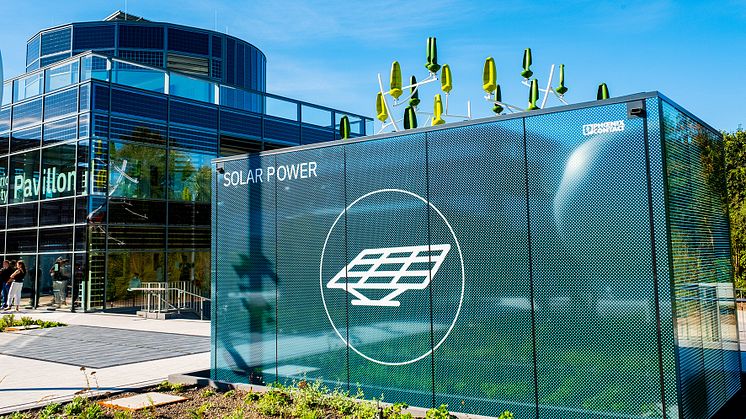
News -
Vision of the future brought to life in the All Electric Society Park
A new entrance has been built on an area of around 7,600 m² along the access road to Phoenix Contact’s Blomberg site.
The centerpiece is a freely accessible park that makes the future vision of the All Electric Society tangible for everyone and explains it in an understandable way. Its hallmark is a solar tree with a diameter of 12 meters on the traffic circle right next to the park. This can be rotated around its central axis so that it is always at the correct angle to the sun.
Using the flow of energy – from generation, through conversion, storage, and distribution, right through to its optimised use – the park demonstrates how the All Electric Society can become a reality. Real applications show how sector coupling works and which technologies facilitate it. The park is a scaled-down reflection of the real world. Cubes made of glass for each application, open-field systems, and a pavilion with a control room and meeting rooms are all part of the exhibition areas of the park. The park conveys a holistic image of how to consume resources sparingly by using existing technologies.
Experience sector coupling in the All Electric Society Park
The common thread running through the park is the flow of energy and data. Following this theme, this thread puts applications into a realistic context to illustrate the mutual influence that they have on each other. The starting point is the generation of renewable energy using solar and wind power. In the park itself, solar panels provide sustainable electricity. They are located on the roofs of the cubes and charging stations, integrated into the facade of the pavilion, and used as floor panels. Around 550 solar panels are installed in the park, generating 155,000 kilowatt hours of electricity per year. The topic of wind power is illustrated in the park by a walk-in wind turbine nacelle as well as a wind tree. Even small breezes turn the tree’s green plastic leaves, which function like turbines to generate energy. With its 36 leaves, called Aeroleafs, the wind tree can generate a total of 10.8 kilowatt-peak of electricity.
Since solar and wind resources are not always available at a constant level, it must be possible to store surplus energy and release it again when needed. As an example, battery storage systems are used for this purpose. Energy loads can then be supplied with this energy at any time when needed. The energy loads in the park are the buildings, the electric charging stations, and the applications in the park itself. These loads are also used to demonstrate various optimisation measures designed to reduce energy demand and the use of resources.
The power generators, energy storage systems, energy loads, and the medium-voltage grid are connected electrically via a secondary substation. An energy management system ensures a balance between the generators, storage systems, and loads. This system ensures that the energy is provided in the necessary current and voltage ranges. The system records all relevant characteristics and controls the corresponding energy flows via the secondary substation. However, it is not just electrical energy that will be needed in the All Electric Society Park, but also other energy carriers. For example, the cubes and the pavilion in the park must be supplied with heating and cooling. This energy flow is controlled by an independent heating and cooling energy management system. The heat loss that occurs during the conversion of energy is also taken into account and utilised. An ice storage tank with two heat pumps is also installed.
These two independent energy management systems for “electrical energy” and “heating/cooling” are combined and managed centrally in a higher-level energy management system. This controls the entire park in all energy areas.
Energy efficiency as important building block for the All Electric Society
When it comes to the control of the energy flows, efficiency measures that reduce energy consumption are just as important as the collection and evaluation of energy consumption and generation data. This is a key point in making the All Electric Society a reality. It is only with the additional reduction of the primary energy demand through efficiency measures that power supply based on renewable resources can work. The park shows various approaches for this with energy-optimised building operation.
The subject of efficiency is also closely related to sustainability. This aspect is also taken into account in the park. The pavilion is built based on the “cradle-to-cradle” principle, which means that only materials that can be recycled have been used. This solution for a continuous and consistent circular economy puts sustainable production in the foreground.
The All Electric Society Park represents the sustainable use of resources and thus provides an example for the realisation of the All Electric Society.
The park has been open to visitors free of charge since September 2023. Extensive information is available on the page linked below to provide you with an initial overview. This enables you to plan the visit in advance.

